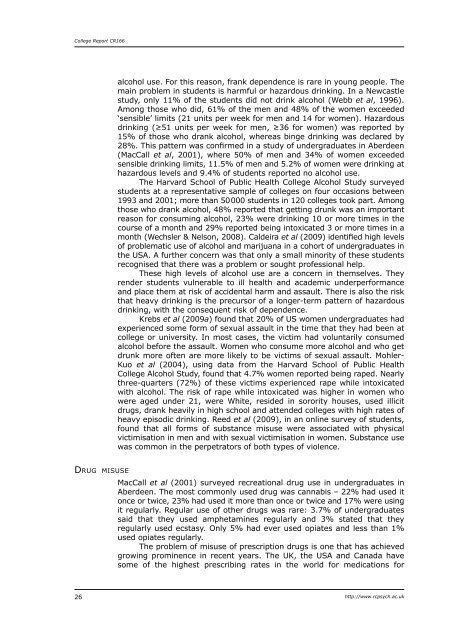Mental health of students in higher education
Mental health of students in higher education - Royal College of ...
Mental health of students in higher education - Royal College of ...
- No tags were found...
You also want an ePaper? Increase the reach of your titles
YUMPU automatically turns print PDFs into web optimized ePapers that Google loves.
College Report CR166alcohol use. For this reason, frank dependence is rare <strong>in</strong> young people. Thema<strong>in</strong> problem <strong>in</strong> <strong>students</strong> is harmful or hazardous dr<strong>in</strong>k<strong>in</strong>g. In a Newcastlestudy, only 11% <strong>of</strong> the <strong>students</strong> did not dr<strong>in</strong>k alcohol (Webb et al, 1996).Among those who did, 61% <strong>of</strong> the men and 48% <strong>of</strong> the women exceeded‘sensible’ limits (21 units per week for men and 14 for women). Hazardousdr<strong>in</strong>k<strong>in</strong>g (≥51 units per week for men, ≥36 for women) was reported by15% <strong>of</strong> those who drank alcohol, whereas b<strong>in</strong>ge dr<strong>in</strong>k<strong>in</strong>g was declared by28%. This pattern was confirmed <strong>in</strong> a study <strong>of</strong> undergraduates <strong>in</strong> Aberdeen(MacCall et al, 2001), where 50% <strong>of</strong> men and 34% <strong>of</strong> women exceededsensible dr<strong>in</strong>k<strong>in</strong>g limits, 11.5% <strong>of</strong> men and 5.2% <strong>of</strong> women were dr<strong>in</strong>k<strong>in</strong>g athazardous levels and 9.4% <strong>of</strong> <strong>students</strong> reported no alcohol use.The Harvard School <strong>of</strong> Public Health College Alcohol Study surveyed<strong>students</strong> at a representative sample <strong>of</strong> colleges on four occasions between1993 and 2001; more than 50 000 <strong>students</strong> <strong>in</strong> 120 colleges took part. Amongthose who drank alcohol, 48% reported that gett<strong>in</strong>g drunk was an importantreason for consum<strong>in</strong>g alcohol, 23% were dr<strong>in</strong>k<strong>in</strong>g 10 or more times <strong>in</strong> thecourse <strong>of</strong> a month and 29% reported be<strong>in</strong>g <strong>in</strong>toxicated 3 or more times <strong>in</strong> amonth (Wechsler & Nelson, 2008). Caldeira et al (2009) identified high levels<strong>of</strong> problematic use <strong>of</strong> alcohol and marijuana <strong>in</strong> a cohort <strong>of</strong> undergraduates <strong>in</strong>the USA. A further concern was that only a small m<strong>in</strong>ority <strong>of</strong> these <strong>students</strong>recognised that there was a problem or sought pr<strong>of</strong>essional help.These high levels <strong>of</strong> alcohol use are a concern <strong>in</strong> themselves. Theyrender <strong>students</strong> vulnerable to ill <strong>health</strong> and academic underperformanceand place them at risk <strong>of</strong> accidental harm and assault. There is also the riskthat heavy dr<strong>in</strong>k<strong>in</strong>g is the precursor <strong>of</strong> a longer-term pattern <strong>of</strong> hazardousdr<strong>in</strong>k<strong>in</strong>g, with the consequent risk <strong>of</strong> dependence.Krebs et al (2009a) found that 20% <strong>of</strong> US women undergraduates hadexperienced some form <strong>of</strong> sexual assault <strong>in</strong> the time that they had been atcollege or university. In most cases, the victim had voluntarily consumedalcohol before the assault. Women who consume more alcohol and who getdrunk more <strong>of</strong>ten are more likely to be victims <strong>of</strong> sexual assault. Mohler-Kuo et al (2004), us<strong>in</strong>g data from the Harvard School <strong>of</strong> Public HealthCollege Alcohol Study, found that 4.7% women reported be<strong>in</strong>g raped. Nearlythree-quarters (72%) <strong>of</strong> these victims experienced rape while <strong>in</strong>toxicatedwith alcohol. The risk <strong>of</strong> rape while <strong>in</strong>toxicated was <strong>higher</strong> <strong>in</strong> women whowere aged under 21, were White, resided <strong>in</strong> sorority houses, used illicitdrugs, drank heavily <strong>in</strong> high school and attended colleges with high rates <strong>of</strong>heavy episodic dr<strong>in</strong>k<strong>in</strong>g. Reed et al (2009), <strong>in</strong> an onl<strong>in</strong>e survey <strong>of</strong> <strong>students</strong>,found that all forms <strong>of</strong> substance misuse were associated with physicalvictimisation <strong>in</strong> men and with sexual victimisation <strong>in</strong> women. Substance usewas common <strong>in</strong> the perpetrators <strong>of</strong> both types <strong>of</strong> violence.Drug misuseMacCall et al (2001) surveyed recreational drug use <strong>in</strong> undergraduates <strong>in</strong>Aberdeen. The most commonly used drug was cannabis – 22% had used itonce or twice, 23% had used it more than once or twice and 17% were us<strong>in</strong>git regularly. Regular use <strong>of</strong> other drugs was rare: 3.7% <strong>of</strong> undergraduatessaid that they used amphetam<strong>in</strong>es regularly and 3% stated that theyregularly used ecstasy. Only 5% had ever used opiates and less than 1%used opiates regularly.The problem <strong>of</strong> misuse <strong>of</strong> prescription drugs is one that has achievedgrow<strong>in</strong>g prom<strong>in</strong>ence <strong>in</strong> recent years. The UK, the USA and Canada havesome <strong>of</strong> the highest prescrib<strong>in</strong>g rates <strong>in</strong> the world for medications for26 http://www.rcpsych.ac.uk





